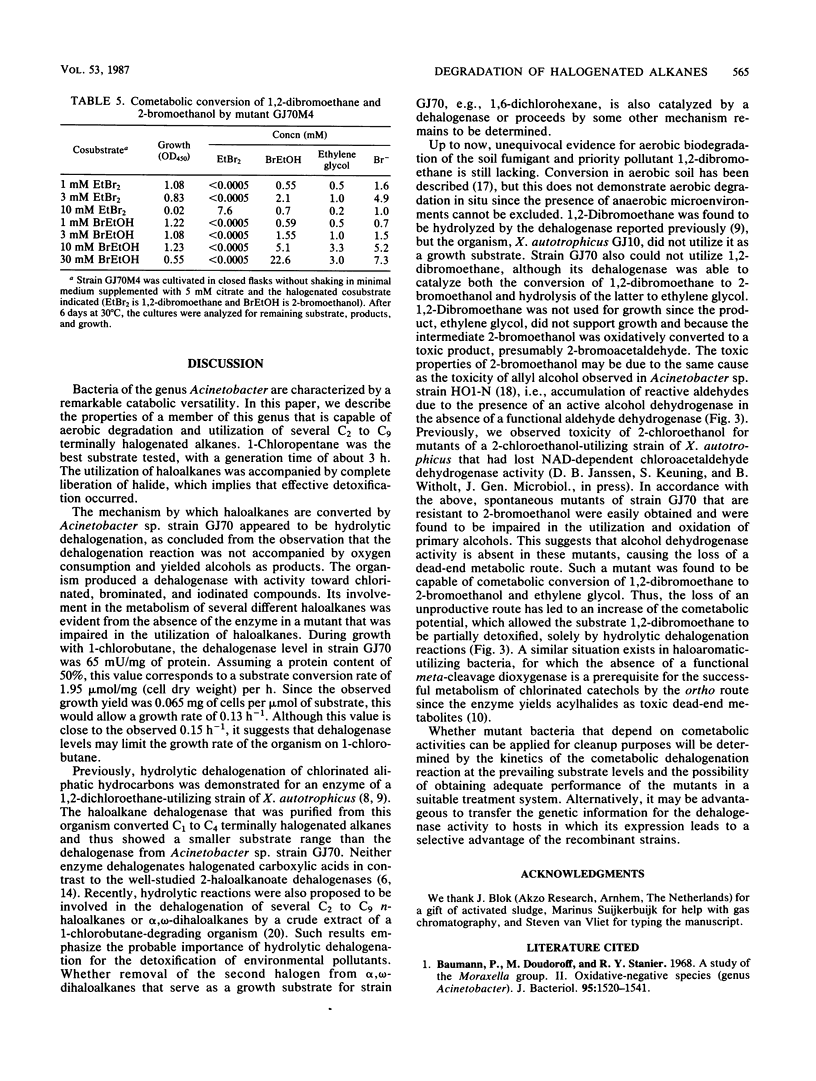Abstract
A 1,6-dichlorohexane-degrading strain of Acinetobacter sp. was isolated from activated sludge. The organism could grow with and quantitatively release halide from 1,6-dichlorohexane, 1,9-dichlorononane, 1-chloropentane, 1-chlorobutane, 1-bromopentane, ethylbromide, and 1-iodopropane. Crude extracts contained an inducible novel dehalogenase that liberated halide from the above compounds and also from 1,3-dichloropropane, 1,2-dibromoethane, and 2-bromoethanol. The latter two compounds were toxic suicide substrates for the organism at concentrations of 10 and 5 microM, respectively. Mutants resistant to 1,2-dibromoethane (3 mM) lacked dehalogenase activity and did not utilize haloalkanes for growth. Mutants resistant to both 1,2-dibromoethane (3 mM) and 2-bromoethanol (30 mM) could no longer oxidize or utilize alcohols and were capable of hydrolytic dehalogenation of 1,2-dibromoethane to ethylene glycol.
Full text
PDF





Selected References
These references are in PubMed. This may not be the complete list of references from this article.
- Baumann P., Doudoroff M., Stanier R. Y. A study of the Moraxella group. II. Oxidative-negative species (genus Acinetobacter). J Bacteriol. 1968 May;95(5):1520–1541. doi: 10.1128/jb.95.5.1520-1541.1968. [DOI] [PMC free article] [PubMed] [Google Scholar]
- Fogel M. M., Taddeo A. R., Fogel S. Biodegradation of chlorinated ethenes by a methane-utilizing mixed culture. Appl Environ Microbiol. 1986 Apr;51(4):720–724. doi: 10.1128/aem.51.4.720-724.1986. [DOI] [PMC free article] [PubMed] [Google Scholar]
- Goldman P., Milne G. W., Keister D. B. Carbon-halogen bond cleavage. 3. Studies on bacterial halidohrolases. J Biol Chem. 1968 Jan 25;243(2):428–434. [PubMed] [Google Scholar]
- Henriksen S. D. Moraxella, Acinetobacter, and the Mimeae. Bacteriol Rev. 1973 Dec;37(4):522–561. doi: 10.1128/br.37.4.522-561.1973. [DOI] [PMC free article] [PubMed] [Google Scholar]
- Janssen D. B., Scheper A., Dijkhuizen L., Witholt B. Degradation of halogenated aliphatic compounds by Xanthobacter autotrophicus GJ10. Appl Environ Microbiol. 1985 Mar;49(3):673–677. doi: 10.1128/aem.49.3.673-677.1985. [DOI] [PMC free article] [PubMed] [Google Scholar]
- Keuning S., Janssen D. B., Witholt B. Purification and characterization of hydrolytic haloalkane dehalogenase from Xanthobacter autotrophicus GJ10. J Bacteriol. 1985 Aug;163(2):635–639. doi: 10.1128/jb.163.2.635-639.1985. [DOI] [PMC free article] [PubMed] [Google Scholar]
- Kohler-Staub D., Leisinger T. Dichloromethane dehalogenase of Hyphomicrobium sp. strain DM2. J Bacteriol. 1985 May;162(2):676–681. doi: 10.1128/jb.162.2.676-681.1985. [DOI] [PMC free article] [PubMed] [Google Scholar]
- LOWRY O. H., ROSEBROUGH N. J., FARR A. L., RANDALL R. J. Protein measurement with the Folin phenol reagent. J Biol Chem. 1951 Nov;193(1):265–275. [PubMed] [Google Scholar]
- Leisinger T. Microorganisms and xenobiotic compounds. Experientia. 1983 Nov 15;39(11):1183–1191. doi: 10.1007/BF01990355. [DOI] [PubMed] [Google Scholar]
- Motosugi K., Soda K. Microbial degradation of synthetic organochlorine compounds. Experientia. 1983 Nov 15;39(11):1214–1220. doi: 10.1007/BF01990358. [DOI] [PubMed] [Google Scholar]
- Omori T., Alexander M. Bacterial and spontaneous dehalogenation of organic compounds. Appl Environ Microbiol. 1978 Mar;35(3):512–516. doi: 10.1128/aem.35.3.512-516.1978. [DOI] [PMC free article] [PubMed] [Google Scholar]
- Omori T., Alexander M. Bacterial dehalogenation of halogenated alkanes and fatty acids. Appl Environ Microbiol. 1978 May;35(5):867–871. doi: 10.1128/aem.35.5.867-871.1978. [DOI] [PMC free article] [PubMed] [Google Scholar]
- Pignatello J. J. Ethylene Dibromide Mineralization in Soils under Aerobic Conditions. Appl Environ Microbiol. 1986 Mar;51(3):588–592. doi: 10.1128/aem.51.3.588-592.1986. [DOI] [PMC free article] [PubMed] [Google Scholar]
- Singer M. E., Finnerty W. R. Alcohol dehydrogenases in Acinetobacter sp. strain HO1-N: role in hexadecane and hexadecanol metabolism. J Bacteriol. 1985 Dec;164(3):1017–1024. doi: 10.1128/jb.164.3.1017-1024.1985. [DOI] [PMC free article] [PubMed] [Google Scholar]


